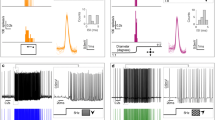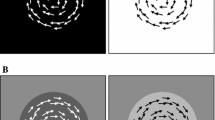Summary
Descending deviation detector neurons (DDNs) of Locusta migratoria are characterized physiologically by their responses to light on/off stimuli, simulated course deviation (rotation of an artificial horizon), passive rotation of the head, frontal wind, and flight activity. The investigation emphasises on the co-processing of exteroceptive input signalling course deviation (mainly movement of the retinal image, but also wind), and proprioceptive input signalling head movement and position. Stimuli were presented in combinations as expected during natural behavior. Eight DDNs are described for the first time, and 3 previously described DDNs are characterized further. Responses to horizon rotation and imposed head movements are assigned to one of 4 response types: (1) the horizon-only type codes retinal slip and/or the position of the horizon in the visual field but ignores cervical proprioception; (2) the head-only type ignores visually simulated course deviation but codes for movement or position of the head; (3) in the compensating type, head rolling causes visual input and cervical proprioceptive input of opposite signs, so that head movements themselves are ignored, whereas course deviations are recognized; (4) in the amplifying type, head rolling causes visual input and cervical proprioceptive input of the same sign, i.e. one input amplifies the other. This classification does not take the various responses to wind into account. In several DDNs, responses to phasic and tonic stimuli of the same modality, and/or responses to deviations about different axes could be assigned to different response types. Activity in DDNs has been shown previously to result in steering responses of wings, legs, abdomen and/or the head. It is proposed that different kinds of flight steering (e.g. corrective course control, “intentional” steering, orientation towards or away from a target) may be controlled by selective enhancement or suppression of responses or motor effects of DDN-subpopulations.
Similar content being viewed by others
Abbreviations
- AP :
-
action potential
- DDN :
-
descending deviation detector neuron
- DNI, DNC, DNM :
-
descending deviation detector neurons receiving major input from the ipsilateral, contralateral, and median ocellus respectively
- PDDSMD :
-
protocerebral, descending direction-selective motion-detecting neuron
- PI(2)5 :
-
descending deviation detector neuron with the cell body in the pars intercerebralis medialis
- TCG :
-
tritocerebral commissure giant neuron
References
Arbas EA (1986) Control of hindlimb posture by wind-sensitive hairs and antennae during locust flight. J Comp Physiol A 159:849–857
Baader A (1989) Mechanisms of flight steering in the locust (Locusta migratoria L.): the neuronal control of steering movements and its behavioral significance. Dissertation, University of Basel, Switzerland
Baader A (1991) Simulation of self-motion in tethered flying insects: an optical flow field for locusts. J Neurosci Methods 38:193–199
Baader A, Schäfer M, Rowell CHF (1992) The perception of the visual flow field: a behavioural and neuronal analysis. J Exp Biol 165:137–160
Bacon J, Möhl B (1983) The tritocerebral commissure giant (TCG) wind-sensitive interneurone in the locust. I. Its activity in straight flight. J Comp Physiol 150:439–452
Bacon J, Tyrer M (1978) The tritocerebral commissure giant (TCG): a bimodal interneurone in the locust, Schistocerca gregaria. J Comp Physiol 126:317–325
Boyan G, Williams JLD (1981) Descending interneurones in the brain of the cricket. Anatomy and responses to auditory stimuli. Naturwissenschaften 67:486–487
Boyan G, Williams JLD, Ball EE (1989) The wind-sensitive cereal receptor/giant interneurone system of the locust, Locusta migratoria. I. Anatomy of the system. J Comp Physiol A 165:495–510
Camhi JM (1969) Locust wind receptors I. Transducer mechanics and sensory response. J Exp Biol 50:335–348
Erickson RP (1982) The across-fiber pattern theory: an organization principle for molar neural function. Contrib Sens Physiol 6:79–110
Gewecke M, Philippen J (1978) Control of the horizontal flightcourse by air-current sense organs in Locusta migratoria. Physiol Entomol 3:43–52
Gewecke M, Kirschfeld K, Feiler R (1990) Identification of optic lobe neurons of locusts by video films. Biol Cybern 63:411–420
Goodman LJ, Fletcher WA, Guy RG, Mobbs PG, Pomfrett DJ (1987) Motion sensitive descending interneurons, ocellar LD neurons and neck motoneurons in the bee: a neural substrate for visual course control in Apis mellifera. In: Menzel R, Mercer A (eds) Neurobiology and behaviour of honeybees. Springer, Berlin Heidelberg New York, pp 158–171
Götz KG (1987) Course-control, metabolism and wing interference during ultralong tethered flight in Drosophila melanogaster. J Exp Biol 128:35–46
Griss C, Rowell CHF (1986) Three descending interneurons reporting deviation from course in the locust. I. Anatomy. J Comp Physiol A 158:765–774
Heisenberg M, Wolf R (1984) Vision in Drosophila. Genetics of micro-behavior. In: Braitenberg V (ed) Studies of brain function, vol XII. Springer, Berlin Heidelberg New York
Hensler K (1988) The pars intercerebralis neurone PI(2)5 of locusts: convergent processing of inputs reporting head movements and deviations from straight flight. J Exp Biol 140:511–533
Hensler K (1989) Corrective flight steering in locusts: convergence of exteroand proprioreceptive inputs in descending deviation detectors. In: Naresh Singh R, Strausfeld NJ (eds) Neurobiology of sensory systems. Plenum, New York, pp 531–554
Hensler K (1992a) Neuronal co-processing of course deviations and head movements in locusts. II. Thoracic interneurons. J Comp Physiol A 171:273–284
Hensler K (1992b) Intracellular recordings from intact locusts flying under closed-loop visual conditions. J Exp Biol 168:301–306
Hensler K, Robert D (1990) Compensatory head movements during corrective flight steering in locusts. J Comp Physiol A 166:685–693
Hensler K, Rowell CHF (1990) Control of optomotor responses by descending deviation detector neurones in intact flying locusts. J Exp Biol 149:191–205
Horsmann U (1985) deDer Einfluß propriozeptiver Windmessung auf den Flug der Wanderheuschrecke und die Bedeutung descendierender Neuronen der Tritocerebralkommissur. Dissertation, Universität Köln, Germany
Ibbotson MR (1991) Wide-field motion-sensitive neurons tuned to horizontal movement in the honey bee, Apis mellifera. J Comp Physiol A 168:91–102
Kien J (1983) The initiation and maintenance of walking in the locust: an alternative to the command concept. Proc R Soc Lond B 219:137–174
Kien J, Altman JS (1984) Descending interneurones from the brain and suboesophageal ganglia and their role in the control of locust behaviour. J Insect Physiol 30:59–72
Miall RC (1990) Visual control of steering in locust flight: the effects of head movement on responses to roll stimuli. J Comp Physiol A 166:735–744
Möhl B, Bacon J (1983) The tritocerebral commissure giant (TCG) wind-sensitive interneurone in the locust. II. Directional sensitivity and role in flight stabilisation. J Comp Physiol 150:453–465
Moiseff A, Pollack GS, Hoy RR (1978) Steering responses of flying crickets to sound and ultrasound: mate attraction and predator avoidance. Proc Natl Acad Sci USA 75:4052–4056
Olberg RM (1981) Parallel encoding of direction of wind, head, abdomen and visual pattern movement by single interneurons in the dragonfly. J Comp Physiol 142:27–41
Olberg RM (1986) Identified target-selective visual interneurons descending from the dragonfly brain. J Comp Physiol A 159:827–840
Olberg RM, Willis MA (1990) Pheromone modulated optomotor response in male gypsy moths, Lymantria dispar L.: Directionally selective visual interneurons in the ventral nerve cord. J Comp Physiol A 167:707–717
Pflüger H-J (1984) The large fourth abdominal intersegmental interneuron: A new type of wind-sensitive ventral cord interneuron in locusts. J Comp Neurol 222:343–357
Preiss R, Gewecke M (1991) Compensation of visually simulated wind drift in the swarming flight of the desert locust (Schistocerca gregaria). J Exp Biol 157:461–481
Rind CR (1983a) A directionally sensitive motion detecting neurone in the brain of a moth. J Exp Biol 102:253–271
Rind CR (1983b) The role of an identified brain neurone in mediating optomotor movements in a moth. J Exp Biol 102:273–284
Rind CR (1990) A directionally selective motion-detecting neurone in the brain of the locust: physiological and morphological characterization. J Exp Biol 149:1–19
Robert D (1988) Visual steering under closed-loop conditions by flying locusts: flexibility of optomotor response and mechanisms of correctional steering. J Comp Physiol A 164:15–24
Robert D (1990) The auditory behaviour of flying locusts. J Exp Biol 147:279–301
Robert D, Rowell CHF (1992) Locust flight steering. II. Acoustic avoidance manoeuvres and associated head movements, compared with correctional steering. J Comp Physiol A 171:53–62
Robertson RM, Pearson KG (1982) A preparation for the intracellular analysis of neural activity during flight in the locust. J Comp Physiol 146:311–320
Robertson RM, Wisniowski L (1988) GABA-like immunoreactivity of identified interneurons in the flight system of the locust, Locusta migratoria. Cell Tissue Res 254:331–340
Rowell CHF (1989) Descending interneurones of the locust reporting deviation from flight course: what is their role in steering? J Exp Biol 146:177–194
Rowell CHF, Reichert H (1986) Three descending interneurons reporting deviation from course in the locust. II. Physiology. J Comp Physiol A 158:775–794
Strausfeld NJ, Bassemir U, Singh RN, Bacon JP (1984) Organizational principles of outputs from dipteran brains. J Insect Physiol 30:73–93
Taylor CP (1981a) Contribution of compound eyes and ocelli to steering of locusts in flight. I. Behavioural analysis. J Exp Biol 93:1–18
Taylor CP (1981b) Contribution of compound eyes and ocelli to steering of locusts in flight. II. Timing changes in flight motor units. J Exp Biol 93:19–31
Thüring DA (1986) Variability of motor output during flight steering in locusts. J Comp Physiol A 158:653–664
Tyrer NM, Gregory GE (1982) A guide to the neuroanatomy of locust suboesophageal and thoracic ganglia. Phil Trans R Soc Lond B 297:91–123
Tyrer NM, Pozza MF, Humbel U, Peters BH, Bacon JP (1988) The tritocerebral commissure “dwarf” (TCD): a major GABA-immunoreactive descending interneuron in the locust. J Comp Physiol A 164:141–150
Watson AHD, Burrows M (1987) Immunocytochemical and pharmacological evidence for GABAergic spiking local interneurones in the locust. J Neurosci 7:1741–1751
Williams JLD (1975) Anatomical studies of the insect central nervous system: A ground-plan of the midbrain and an introduction to the central complex in the locust, Schistocerca gregaria (Orthoptera). J Zool Lond 176:67–86
Wilson M (1978) The functional organization of locust ocelli. J Comp Physiol 124:297–316
Author information
Authors and Affiliations
Rights and permissions
About this article
Cite this article
Hensler, K. Neuronal co-processing of course deviation and head movements in locusts. J Comp Physiol A 171, 257–271 (1992). https://doi.org/10.1007/BF00188933
Accepted:
Issue Date:
DOI: https://doi.org/10.1007/BF00188933




